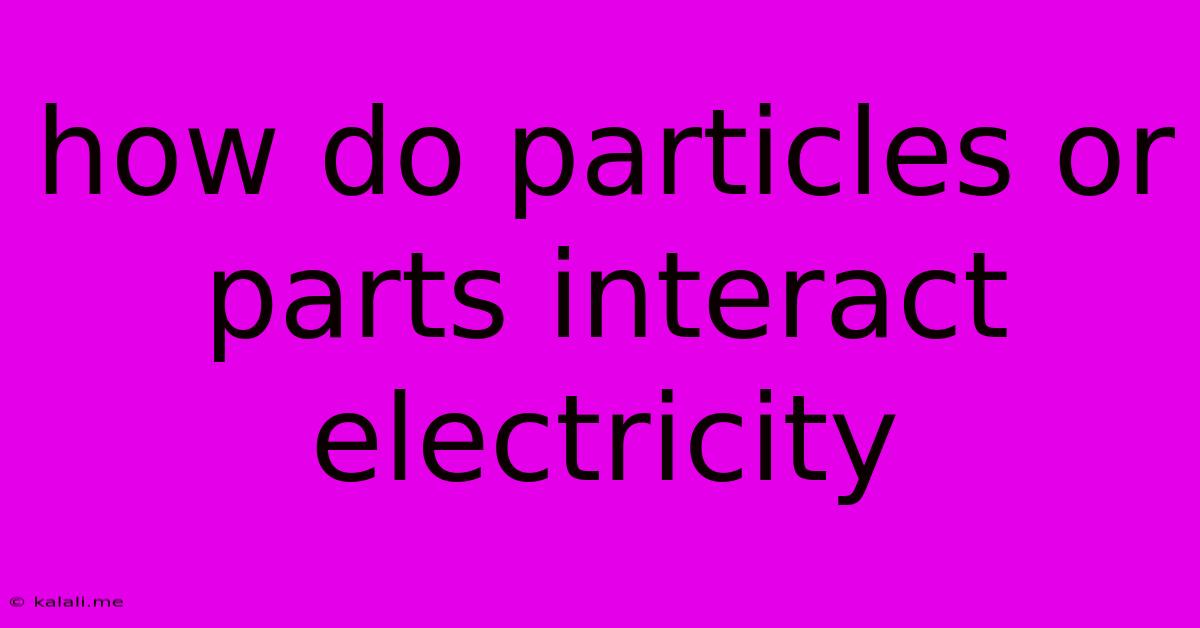How Do Particles Or Parts Interact Electricity
Kalali
May 23, 2025 · 3 min read

Table of Contents
How Do Particles and Parts Interact with Electricity?
Electricity, at its core, is the flow of electric charge. This charge is carried by subatomic particles, primarily electrons, and their interaction with various materials and components forms the basis of all electrical phenomena. Understanding these interactions is key to comprehending how circuits work, from simple light bulbs to complex computer systems. This article will explore the fundamental principles behind how particles and components interact with electricity.
Understanding Electric Charge and Current
At the atomic level, atoms consist of protons (positively charged), neutrons (neutral), and electrons (negatively charged). Electricity involves the movement of these charged particles. Specifically, it's usually the flow of electrons that constitutes an electric current. When electrons move in a coordinated fashion through a material, we have an electric current, measured in amperes (amps). The movement itself is driven by an electric potential difference, or voltage, which essentially represents the "pressure" pushing electrons through a conductor.
Conductors, Insulators, and Semiconductors
Materials behave differently when it comes to electric current flow, largely due to the arrangement and mobility of their electrons.
-
Conductors: These materials, like copper and silver, have loosely bound electrons in their outermost shells. These electrons are free to move relatively easily, allowing electric current to flow readily. This is why copper wires are commonly used in electrical circuits. The conductivity is determined by factors like the material's resistivity and temperature.
-
Insulators: Materials like rubber and glass have tightly bound electrons. Their electrons are not easily freed, making it very difficult for electric current to flow through them. Insulators are crucial for safety, preventing electric shocks and short circuits.
-
Semiconductors: These materials, such as silicon and germanium, exhibit intermediate conductivity. Their conductivity can be controlled by adding impurities (doping), allowing for the creation of transistors and integrated circuits, the building blocks of modern electronics. The behavior of semiconductors forms the basis of modern electronics and digital logic.
Interactions at the Component Level:
Various electrical components interact with electricity in different ways, leveraging the properties of conductors, insulators, and semiconductors. Let's look at some key examples:
-
Resistors: Resistors impede the flow of current, converting some of the electrical energy into heat. This resistance is measured in ohms. They are essential for controlling current and voltage levels in circuits.
-
Capacitors: Capacitors store electrical energy in an electric field. They consist of two conductive plates separated by an insulator. They can temporarily store charge and release it later, playing a crucial role in filtering and smoothing signals.
-
Inductors: Inductors store energy in a magnetic field. They consist of a coil of wire, and their ability to oppose changes in current is known as inductance (measured in Henries). Inductors are vital in filtering and energy storage applications.
-
Diodes: Diodes allow current to flow in one direction only, acting as one-way valves for electricity. This property is essential for rectifying alternating current (AC) into direct current (DC).
-
Transistors: Transistors act as switches or amplifiers, controlling the flow of current based on a small input signal. This ability is central to digital logic and amplification in electronic circuits.
Beyond the Basics: Quantum Effects
At a more advanced level, quantum mechanics plays a crucial role in understanding the behavior of electrons in materials and components. For example, the behavior of electrons in semiconductors is fundamentally governed by quantum mechanical principles. This understanding is essential for developing new electronic devices and materials with improved performance. Quantum phenomena influence the efficiency and capabilities of advanced electronic systems.
In conclusion, the interaction of particles and components with electricity is a complex interplay of atomic structure, material properties, and circuit design. Understanding these fundamental principles is essential for comprehending how electrical systems work and for developing new technologies. The ongoing exploration of these interactions promises further advancements in the field of electronics and beyond.
Latest Posts
Latest Posts
-
How To Fix Leaking Pvc Joint Without Cutting
May 23, 2025
-
Set Phone To Silent On Schedule
May 23, 2025
-
How To Know If My Macbook Is Charging
May 23, 2025
-
Salesforce Data Raport Output Group By Json
May 23, 2025
-
Blender 4 Liquid Drops Not Falling
May 23, 2025
Related Post
Thank you for visiting our website which covers about How Do Particles Or Parts Interact Electricity . We hope the information provided has been useful to you. Feel free to contact us if you have any questions or need further assistance. See you next time and don't miss to bookmark.